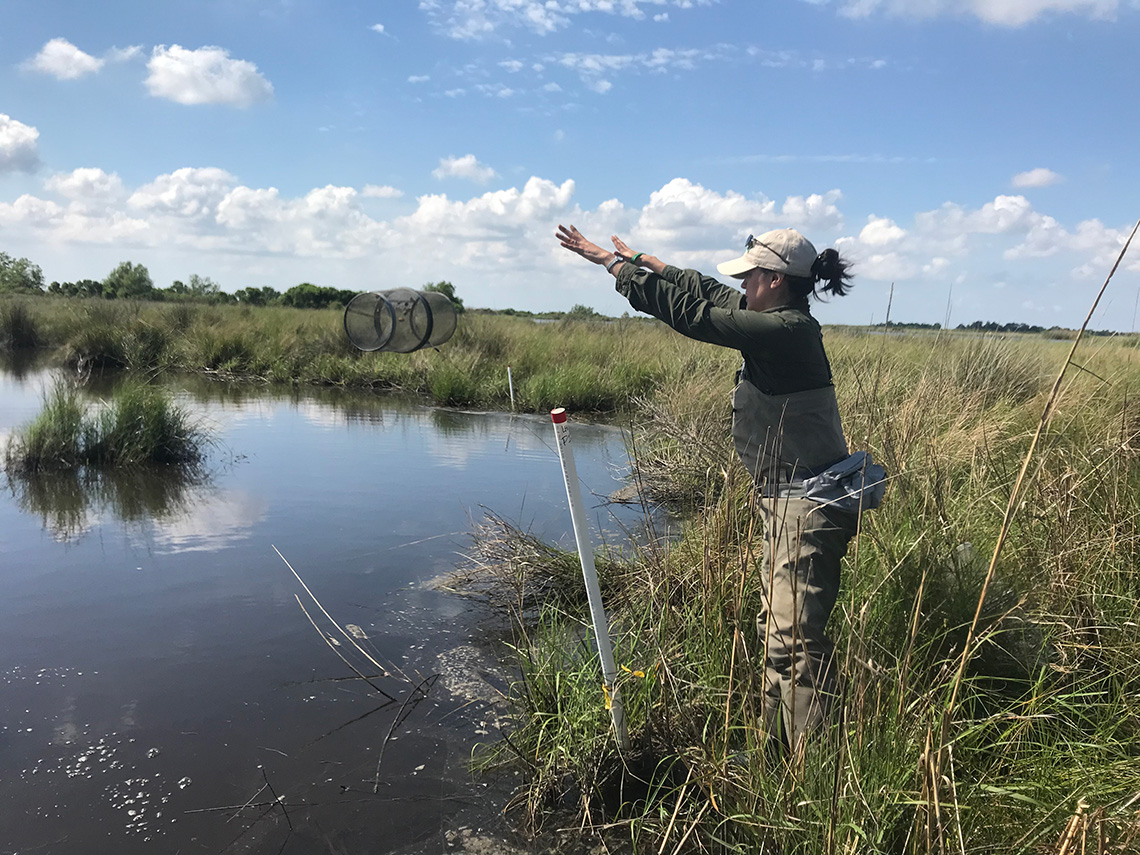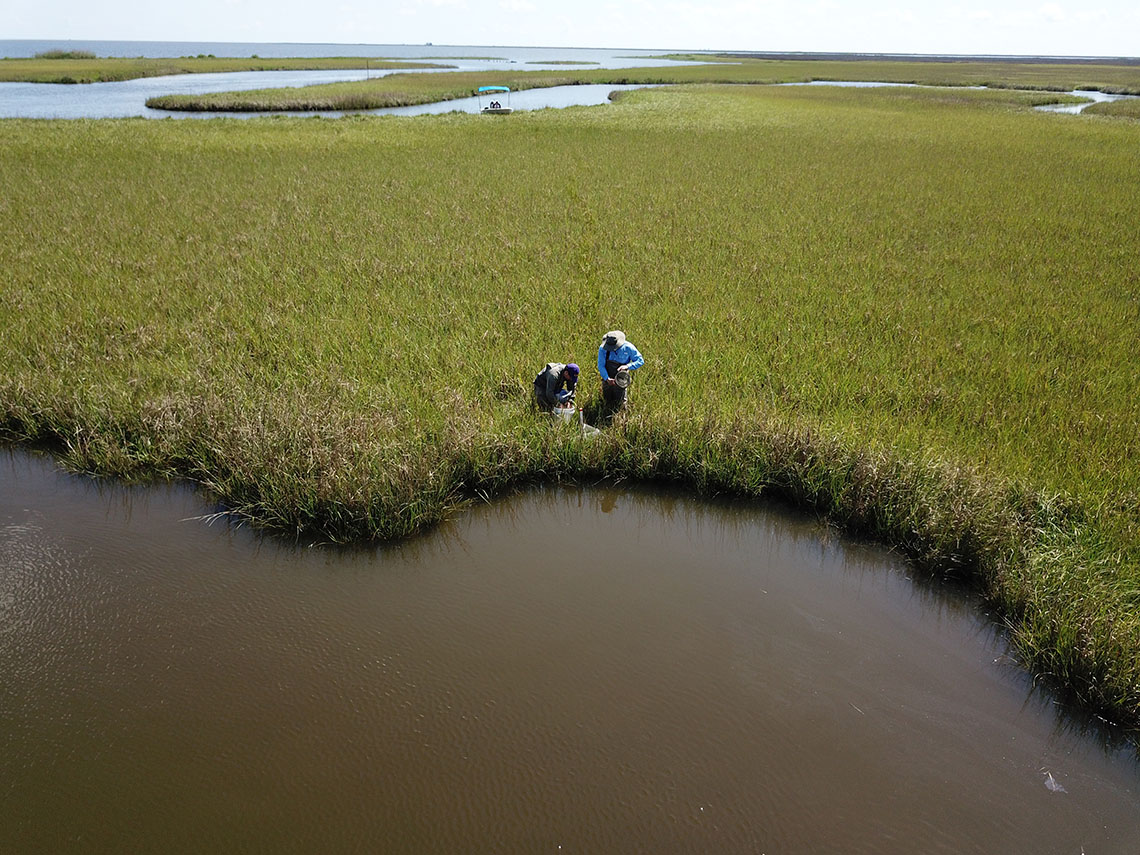If You Build It, They Will Come: Study Supports Marsh Creation as a Tool to Restore Coastal Louisiana
March 16, 2023

A scientist deploying a minnow trap within a marsh pond at a natural marsh site in Lake Hermitage, Plaquemines Parish, Louisiana.
– Photo Credit: Allison Benelli, © Louisiana State University
BATON ROUGE - Louisiana’s newly released draft of the state’s 2023 Coastal Master Plan proposes to spend $16 billion on the construction of new tidal marshes as a key strategy to combat coastal land loss. An important question is whether these newly created marshes will be similar in ecological value to the existing natural marshes. A new study published in the journal Ecosphere and funded by the NOAA RESTORE Science Program addresses this issue, and the results provide positive news for the state’s plans to rebuild the coastline.
“This work is really exciting because it shows that when they’re carefully designed, restored marshes very rapidly become indistinguishable from natural marshes, from an ecological standpoint,” said Melissa Carle, Monitoring and Adaptive Management Team Lead for Deepwater Horizon restoration with NOAA Fisheries’ Restoration Center. “The research here suggests that if you build it right, all of the organisms that make up a healthy marsh community will come.”
The multi-institutional research team was headed by Michael Polito, an associate professor at LSU’s Department of Oceanography & Coastal Sciences, or DOCS, and included fellow DOCS Professor Nancy Rabalais, Department of Environmental Sciences Professor Linda Hooper-Bui, and researchers from University of Wisconsin-Madison, Michigan Technological University, University of Florida, University of North Carolina at Charlotte, University of Tennessee at Knoxville and the Louisiana Universities Marine Consortium.
They focused their work on the tidal marshes of Barataria Bay near Plaquemines Parish, Louisiana, and used a wide range of sampling methods to make side-by-side comparisons of the living organisms found in created and naturally occurring marshes; everything from fish, shrimp, crabs, arthropods and worms to plants and microbes in the soil.
“We found broadly similar biodiversity in created and natural marshes, which provides support for marsh creation as a tool to offset land loss and restore coastal habitats,” said Polito. “In other words, the plants and animals that make Louisiana's natural coastal marshes a heathy and productive ecosystem also make themselves quite at home in the state’s man-made coastal marshes.”
Measuring Marsh Biodiversity

Scientists sampling fish along the marsh edge at a natural marsh in Bay Batiste, Louisiana.
– Photo Credit: Eddie Weeks, © Louisiana State University
Biodiversity is hard to measure—creating a framework for understanding the abundance and health of a wide array of marsh species is no easy task. The team took into account different aspects of biodiversity, such as abundance, or the number of individuals of each species, and richness, which is defined as the overall number of species in an area.
“Organisms have different niches, and, therefore, respond to the environment at different scales and degrees,” said Friedrich Keppler of the University of Wisconsin-Madison and the lead author of the paper on the study along with graduate student Maggie Shaw, also of UW-Madison, and post-doctoral researcher James Junker of Michigan Technological University. “We used new statistical approaches that allowed us to make robust comparisons of marsh biodiversity at different spatial scales and identify the similarities and differences between natural and created marshes.”
While created and natural marshes were remarkedly similar, the study did observe a few subtle differences in the abundance and composition of infauna, a term for soil-dwelling worms and crustaceans, and soil microbes. The study attributes those differences to slightly higher elevation and drier, sandier soils found at one created marsh site, a finding the study authors said highlighted the importance of designing marsh construction projects that replicate the elevation and hydrological conditions found at nearby natural marshes. Carefully designing new construction projects in this manner will make the resulting marshes more likely to support the diverse array of microbes, plants and animals found in natural marshes.
NOAA officials noted the importance of studies like this as part of the ongoing exploration of restoring the coastline.
"Louisiana is losing a football field's worth of coastal wetlands every 100 minutes," said Ian Zink, Marine Habitat Resource Specialist with NOAA Fisheries’ Restoration Center, a division of NOAA’s Office of Habitat Conservation. "Marsh creation can be a powerful tool to restore coastlines damaged by erosion, sea level rise, subsidence and disasters like hurricanes and oil spills. This work improves our understanding of how created marshes can mimic the ecological structure and function of natural marsh habitats to support important fisheries, such as redfish, shrimp and blue crab.”
Access images, videos and captions related to this study.
Read more about research conducted as part of the NOAA Restore Marsh Food Webs Project.